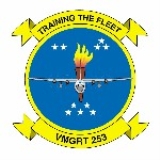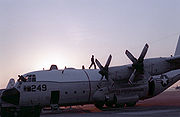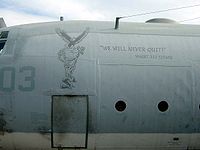
VMGRT-253
Encyclopedia
Marine Aerial Refueler Transport Training Squadron 253 (VMGRT 253) was based at Marine Corps Air Station Cherry Point
, North Carolina
, and responsible for providing the Fleet Marine Force
active-duty and reserve KC-130 squadrons with qualified replacement pilots and enlisted aircrew. Known as the "Titans", VMGRT-253 was a subordinate unit of Marine Aircraft Group 14
, 2nd Marine Aircraft Wing
.
As the model manager for the Marine Corps' KC-130 community, VMGRT-253 is charged with maintaining standardization throughout the fleet. Until 1989, VMGRT-253 was also the Fleet Replacement Enlisted Skills Training Center (FREST), tasked with training all the KC-130 maintenance crew Marines and Sailors. As the Model Manager for maintenance training, VMGRT-253 consolidated East and West Coast technical schools into a new 43000 square feet (3,994.8 m²) facility.
 In addition to improving the aircrew and maintenance personnel of 10 Navy
In addition to improving the aircrew and maintenance personnel of 10 Navy
and Marine Corps squadrons, VMGRT-253 stands ready to augment forward deployed operational units. During Operation Desert Storm VMGRT-253 was tasked with providing tankers to requalify numerous fixed wing jet pilots in aerial refueling prior to deploying to the desert. Additionally, after Hurricane Hugo
in 1989 and Hurricane Andrew
in 1992, VMGRT-253 crews and aircraft provided disaster relief support. In March 1996 the Titans completed their first ever full deployment. While deployed in Key West
for two weeks the squadron carried out all normal assignments and flew an aggressive flight schedule.
In 2000, VMGRT-253 broke new ground when it became the first Marine Corps squadron to receive the KC-130J
. The J-Flight Introduction Team (JFIT) was formed and the squadron was tasked with building a training program and training the aircrews. December 20, 2002, VMGRT-253 transferred its KC-130J’s and personnel to VMGR-252.
In 2005, VMGRT-253 flew 67 sorties and 137.2 hours, carrying 405911 lb (184,118.1 kg) of cargo and 236 passengers in support of Hurricane Katrina relief efforts. The squadron also aided the evacuation efforts of aircraft and personnel aboard MCAS Cherry Point during Hurricane Ophelia to Wright-Patterson AFB.
The squadron was officially deactivated during a ceremony on September 14, 2006. LtCol Adam Holmes (the last commander of the unit) cased the unit colors, which were placed in storage.

Marine Corps Air Station Cherry Point
Marine Corps Air Station Cherry Point or MCAS Cherry Point is a United States Marine Corps airfield located in Havelock, North Carolina, USA, in the eastern part of the state...
, North Carolina
North Carolina
North Carolina is a state located in the southeastern United States. The state borders South Carolina and Georgia to the south, Tennessee to the west and Virginia to the north. North Carolina contains 100 counties. Its capital is Raleigh, and its largest city is Charlotte...
, and responsible for providing the Fleet Marine Force
Fleet Marine Force
The United States Fleet Marine Forces are combined general and special purpose forces within the United States Department of the Navy that are designed in engaging offensive amphibious or expeditionary warfare and defensive maritime employment...
active-duty and reserve KC-130 squadrons with qualified replacement pilots and enlisted aircrew. Known as the "Titans", VMGRT-253 was a subordinate unit of Marine Aircraft Group 14
Marine Aircraft Group 14
Marine Aircraft Group 14 is a United States Marine Corps aviation unit based at Marine Corps Air Station Cherry Point, North Carolina that is currently composed of four AV-8B Harrier squadrons, four EA-6B Prowler squadrons, one KC-130 squadron and a maintenance and logistics...
, 2nd Marine Aircraft Wing
2nd Marine Aircraft Wing
The 2nd Marine Aircraft Wing is the major east coast aviation unit of the United States Marine Corps and is based at Marine Corps Air Station Cherry Point, North Carolina...
.
Mission
Tasked with the initial training of all KC-130 pilots, Tactical System Operators (Navigators), Flight Engineers, Loadmasters, and First Mechanics. The squadron delivers combat capable crews to the fleet KC-130 squadrons, thus allowing the fleet squadrons to concentrate on tactical awareness and preparation. Refresher training is also provided for Marine aviators returning to flying duty after extended ground assignments. The squadron employs 5 KC-130F aircraft, in order to complete its mission of training 30 Aviators, 24 Tactical System Operators, 8 Flight Engineers, 22 Loadmasters, and 30 Flight Mechanics each year.As the model manager for the Marine Corps' KC-130 community, VMGRT-253 is charged with maintaining standardization throughout the fleet. Until 1989, VMGRT-253 was also the Fleet Replacement Enlisted Skills Training Center (FREST), tasked with training all the KC-130 maintenance crew Marines and Sailors. As the Model Manager for maintenance training, VMGRT-253 consolidated East and West Coast technical schools into a new 43000 square feet (3,994.8 m²) facility.
History
The squadron was activated on October 1, 1986 as Marine Aerial Refueler Transport Training Squadron 253 (VMGRT-253). They received their first C-130 Hercules aircraft, bureau number 149803 on November 20, 1986. The squadron held its official commissioning ceremony on January 30, 1987.
United States Navy
The United States Navy is the naval warfare service branch of the United States Armed Forces and one of the seven uniformed services of the United States. The U.S. Navy is the largest in the world; its battle fleet tonnage is greater than that of the next 13 largest navies combined. The U.S...
and Marine Corps squadrons, VMGRT-253 stands ready to augment forward deployed operational units. During Operation Desert Storm VMGRT-253 was tasked with providing tankers to requalify numerous fixed wing jet pilots in aerial refueling prior to deploying to the desert. Additionally, after Hurricane Hugo
Hurricane Hugo
Hurricane Hugo was a classical, destructive and rare Cape Verde-type hurricane which struck the Caribbean islands of Guadeloupe, Montserrat, St. Croix, Puerto Rico and the USA mainland in South Carolina as a Category 4 hurricane during September of the 1989 Atlantic hurricane season...
in 1989 and Hurricane Andrew
Hurricane Andrew
Hurricane Andrew was the third Category 5 hurricane to make landfall in the United States, after the Labor Day Hurricane of 1935 and Hurricane Camille in 1969. Andrew was the first named storm and only major hurricane of the otherwise inactive 1992 Atlantic hurricane season...
in 1992, VMGRT-253 crews and aircraft provided disaster relief support. In March 1996 the Titans completed their first ever full deployment. While deployed in Key West
Key West
Key West is an island in the Straits of Florida on the North American continent at the southernmost tip of the Florida Keys. Key West is home to the southernmost point in the Continental United States; the island is about from Cuba....
for two weeks the squadron carried out all normal assignments and flew an aggressive flight schedule.
In 2000, VMGRT-253 broke new ground when it became the first Marine Corps squadron to receive the KC-130J
Lockheed Martin KC-130
The Lockheed Martin KC-130 is the basic designation for a family of the extended-range tanker version of the C-130 Hercules transport aircraft modified for aerial refuelling. The KC-130J is the latest variant operated by the United States Marine Corps, with 38 delivered out of 47 ordered...
. The J-Flight Introduction Team (JFIT) was formed and the squadron was tasked with building a training program and training the aircrews. December 20, 2002, VMGRT-253 transferred its KC-130J’s and personnel to VMGR-252.
In 2005, VMGRT-253 flew 67 sorties and 137.2 hours, carrying 405911 lb (184,118.1 kg) of cargo and 236 passengers in support of Hurricane Katrina relief efforts. The squadron also aided the evacuation efforts of aircraft and personnel aboard MCAS Cherry Point during Hurricane Ophelia to Wright-Patterson AFB.
The squadron was officially deactivated during a ceremony on September 14, 2006. LtCol Adam Holmes (the last commander of the unit) cased the unit colors, which were placed in storage.
Safety
With the most diverse training requirements in the Marine Corps, the squadron has achieved impressive milestones. Since its commissioning, VMGRT-253 has flown over 19 years without a class “A” mishap while teaching the least experienced aircrew, making over 5000 landings a year and achieving 55,000 total flight hours in the oldest aircraft in the Fleet. The Titans have received awards for both safety and community service. VMGRT-253 has received 8 consecutive Fleet Marine Force Aviation Safety Awards and 2 Commandant’s Unit Awards for mishap free flight time.
See also
- List of inactive United States Marine Corps aircraft squadrons
- United States Marine Corps AviationUnited States Marine Corps AviationUnited States Marine Corps Aviation is the air component of the United States Marine Corps. Marine aviation has a very different mission and operation than its ground counterpart, and thus, has many of its own histories, traditions, terms, and procedures....

